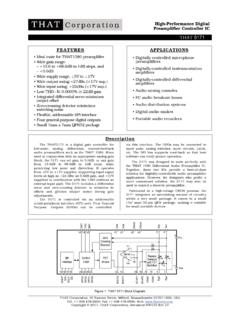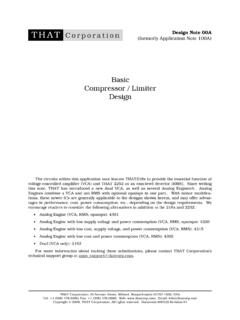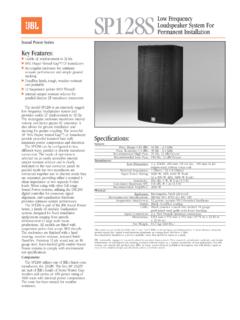Transcription of Improving Loudspeaker Signal Handling Capability
1 The circuits within this application note feature THAT4301 Analog Engine to provide theessential elements of voltage-controlled amplifier (VCA) and rms-level detector (RMS). Sincewriting this note, THAT has introduced several new models of Analog Engines, as well as newVCAs. With minor modifications, these newer ICs are generally applicable to the designs shownherein, and may offer advantages in performance, cost, power consumption, etc., depending onthe design requirements. As well, a standalone RMS is available to complement our standaloneVCAs. We encourage readers to consider the following alternatives in addition to the 4301: Low supply voltage and power consumption: 4320 Low cost, supply voltage, and power consumption: 4315 Low cost and power consumption: 4305 High-performance (VCA only): 2180-series, 2181-series Dual (VCA only): 2162 RMS (standalone): 2252 For more information about making these substitutions, please contact THAT Corporation'stechnical support group at Note 04(formerly Application Note 104)THAT Corporation; 45 Sumner Street, Milford, Massachusetts 01757-1656; USATel: +1 (508) 478-9200; Fax: +1 (508) 478-0990; Web.
2 Email: 1999, THAT Corporation; All rights reserved. Document 600137 Revision 01 ImprovingLoudspeaker Signal HandlingCapabilityImproving Loudspeaker Signal Handling CapabilityIntroductionWhile the Signal - Handling capabilities of speak-ers have improved dramatically over the past de-cade, most systems lack intelligent management ofsignals at or near maximum levels. This is partic-ularly true of low-cost powered speaker systemsused with multimedia computers. These systemsare often further compromised by having a singlespeaker driver Handling either the entire audioband or, at least, both the bass and midrange systems may also have limitedpower Handling Capability , particularly at low adaptive low-frequency limiter presentedhere will allow users to drive these types of pow-ered loudspeakers to higher Signal levels withoutaudible clipping or result is alow-cost, intelligent Signal Handling circuit thatbetter protects the speaker drivers, while increas-ing the perceived dynamic range (headroom)
3 Of thespeaker and amplifier should be noted that no practical limiter ofany kind will react instantaneously. Therefore, thefirst step in creating a system with maximumheadroom is to ensure that short-term clipping ishandled in a well behaved manner. The amplifiermay inherently clip cleanly itself, or a simple di-ode clipper may be employed between the limiterand the amplifier input peak limiting circuits are oftenused to prevent clipping. However, peak detectorsare not an optimum choice for many speaker/am-plifier systems because they tend to react soquickly to signals which exceed their threshold often more quickly than needed when the Signal isof such short-duration that the clipping would benearly inaudible.
4 Compounding this problem isthe peak detector s release time, typically setrather slow to minimize distortion induced by thedetector ripple associated with more rapid timeconstants. The usual outcome is a limiter whichtoo quickly reduces system gain even onshort-term, transient events, and then takes awhile to recover. The audible effect has been de-scribed as punching a hole in the detection provides a much bettercompromise because it reacts in response to totalenergy, rather than waveshape. The true-rms lim-iter will allow overloads of short duration to beclipped by the amplifier itself or by an externalclipper as discussed earlier.
5 Since these transientevents are generally not audible, no limiting is re-quired. Should the Signal remain in clipping longenough to risk becoming audible, the true-rmslimiter will act to reduce the Signal level. The re-sult is a limiter which better maintains headroomby not over-reacting to short-term peaks, therebyminimizing the need to reduce the gain of the Corporation; 45 Sumner Street; Milford, Massachusetts 01757-1656; USATel: +1 (508) 478-9200; Fax: +1 (508) 478-0990; Web: 1999, THAT Corporation; Document 600137 Rev 01 THATC orporationDesign Note 04(formerly Application Note 104) Improving Loudspeaker Signal Handling CapabilityAbstractPowered speakers are an increasingly impor-tant product category in almost every marketwhere speakers are sold from home theaterand multimedia, to custom installations andsound advantage of a powered speaker is thatthe amplifier always drives a known load.
6 De-signers can further exploit the opportunity thispresents by providing some intelligent controlof the Signal driving the load to further optimizeperformance and application note describes a method forincreasing perceived headroom by compressingbass frequencies above some threshold signallevel. If performed judiciously, the headroom ofthe speaker system can be extended without no-ticeable degradation in sonic circuits presented here, then, provide ex-tended perceived headroom over systems with nosignal level management, or systems which usepeak limiting. They do this by preferentially limit-ing low-frequency content (where overload typi-cally occurs), and by ensuring that the systemdoes not over-react to peaks of short of OperationThe recommended circuit, presented in Figure1, acts as a low-frequency above-threshold comprises a derived filter , a true-rms signallevel detector, and a voltage-controlled amplifier(VCA).
7 These three circuit elements are all builtwith a single THAT 4301 Analog Engine , a ver-satile integrated circuit which includes therms-level detector, a decibel-linear VCA (whosegain changes exponentially with the applied con-trol voltage), and three general-purpose opera-tional following sections describe the variousfunctional blocks in more Derived FilterOne derived filter topology is shown in Figure2A. The virtue of this type of filter is that whenthe lowpass output and highpass outputs aresummed together at unity gain, the original signalis restored, unaltered in amplitude or circuit formed by OA1, R15-16, and C7-8is a Sallen-Key lowpass filter with a cutoff fre-quency of 100 Hz, which can easily be adjustedby changing R15 and R16, or C7 and C8 appropri-ately.
8 See the table labeled Sallen-Key LowpassFilter in Table 1 for the component values cover-ing an appropriate range of output of this lowpass filter goes to thecompressor and to the differential amplifierformed by R11-14 and OA2. This differential am-plifier derives the inverted highpass output bysubtracting the lowpass output from the input sig-nal. The highpass Signal is later summed, uncom-pressed, with the compressed lowpass Signal inthe appropriate phase at the output of the should be have tolerances of no worseTHAT Corporation; 45 Sumner Street; Milford, Massachusetts 01757-1656; USATel: +1 (508) 478-9200; Fax: +1 (508) 478-0990; Web: 1999, THAT Corporation.
9 All rights 600137 Rev 01 Page 2 of 7 Design Note 04 Improving Loudspeaker Signal Handling Capability687OA2U1C4301P181920OA1U1D4301 PR1110kR1210kR1310kR1410kR157k87R1614k7C 7220nC8100nInputCut offfrequency100 HzIT2CT5IN1 OUT4 RMSU1B4301PR145k3R61M6C247uV-R21MV+Thres holdC422u1312OA3IN17EC+15EC-16 SYM14V-10 GND9V+11 OUTU1A4301PR320kR420kC647pC522uV-R7300kV -VR150kR9 51RR520kOutputV+V+R87k5V-VR310kR1010RV+V CAO ptionalOptionalSymmetryGain TrimFigure 1. Complete limiter schematicTHAT Corporation; 45 Sumner Street; Milford, Massachusetts 01757-1656; USATel: +1 (508) 478-9200; Fax: +1 (508) 478-0990; Web: 1999, THAT Corporation; All rights 600137 Rev 01 Page 3 of 7 Design Note 04 Improving Loudspeaker Signal Handling Capability687OA2U1C4301P181920OA1U1D4301 PR1110kR1210kR1310kR1410kR157k87R1614k7C 7 220nC8100nCut off freq =100Hz687OA2U1C4301P181920OA1U1D4301PR11 10kR1210kR1310kR1410kR1522k76R1611k3C710 0nC8100nHighpass OutLowpass OutLowpass OutHighpass OutInputC247uInputC247uCut off freq =100 HzADerived Highpass FilterBDerived Lowpass FilterFigure 2.
10 Derived filtersSallen-Key Lowpass Filter(for use with derived Highpass filter)FreqC7C8R15R16100220 nF100 nF100 nF100 nF100 nF100 nF100 nF100 1 Sallen-Key Highpass Filter(for use with derived Lowpass filter)FreqC7C8R15R16100100 nF100 nF100 nF100 nF100 nF100 nF100 nF100 2than 1%, since their tolerances will essentially de-termine the CMRR of the differential amplifier,and hence the leakage between lowpass and high-pass 2B shows another permutation of a de-rived filter. In this circuit, the lowpass portion ofthe Signal is derived, which results in the ability toachieve greater low frequency compression sincethe derived Signal always has a slope of 6dB/oc-tave, regardless of the roll-off of the filter that isused to derive it.















